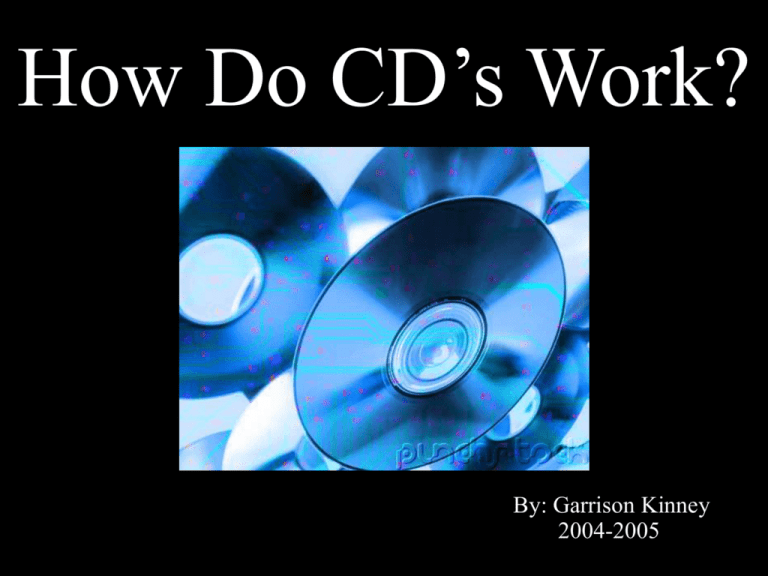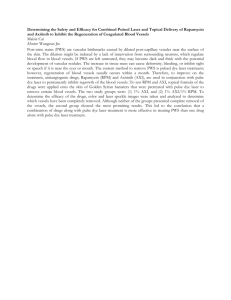CDs_GarrisonK
advertisement

How Do CD’s Work? By: Garrison Kinney 2004-2005 CD’s •The disc is 1.2mm thick •120mm in diameter •117mm of data area • •They can hold 783MB(Mega Bytes) of digital data CD’s •CD’s can store up to 80 minutes of music and up to 99 tracks •It is made of an injection-molded piece of clear polycarbonate plastic The Bumps When the CD is made is covered with tiny bumps in an extremely long line of data. These Bumps are the actual music in digital form of 1’s and 0’s. The Bumps The bumps are read by a laser and put in a digital form of 1’s and 0’s. The raised areas, or the lands, are 0’s and the flat area, or the pits, area are 1’s. The CD Player The main parts of a CD player are the drive motor, the laser, the lens system, and the tracking mechanism. The CD Player The laser and the lens system read the bumps. The tracking mechanism moves the laser to follow the bumps. The drive motor spins the disc. How the CD player Reads the CD The CD is covered in a reflective metal (usually aluminum). The laser hits the bumps and the laser is reflected to an opto – electronic device that reads the digital data. The Digital information is then put through a DAC(Digital How the CD Player Reads the CD You then have an electric signal that humans can here. It is so quiet you can here the sound. The signal is then put through an amp so it is loud enough so you can here it. After it goes through the amp it goes through the speakers so you can hear it. The CD Burner The CD Burner laser moves the same way as the read laser, from the inside out. CD’s with no data on them that are waiting to be “burned” are covered with a translucent dye. How the CD Burner Works The write laser “burns” the dye to simulate bumps. The dye contains compounds of silver, antinomy, tellurium, and indium. In order to rewrite on a CD the laser must heat the dye to the melting temperature of these compounds, which is 600 DEG. C. CD Burner When you heat the dye to 600 DEG. C, it will cause the dye to melt, which makes the dye translucent again. You then can re burn the CD. You must let the CD stay at 200 DEG. C, so the re burned bump pattern will stay. This process of letting the dye cool is called crystallization. About Me My name is Garrison Kinney. I am 13 years old. I love to play basketball, watch movies, watch T.V, swim and hang out with friends. My favorite food is crab legs. They are so good! I have two cats. Their names are Hunter and Savannah. Brian, Marshall. “How CDs Work.” How Stuff Works.com.2005.26 April 2005 <http://electronics.howstuffworks.com/cd.htm>. “Compact Disc.” Microsoft Encarta Online Encyclopedia. 2005. Microsoft Corporation. 27 April 2005 <http://encarta.msn.com/encyclopedia_7615649/Compact_Disc.html>. Pohlmann, Ken C. The Compact Disc Handbook, 2nd Edition. Middleton, WI: A-R Editions, Inc., 1992. “Sound Recording.” The Kingfisher Science Encyclopedia. New York: Kindfisher Publications, 2000.





